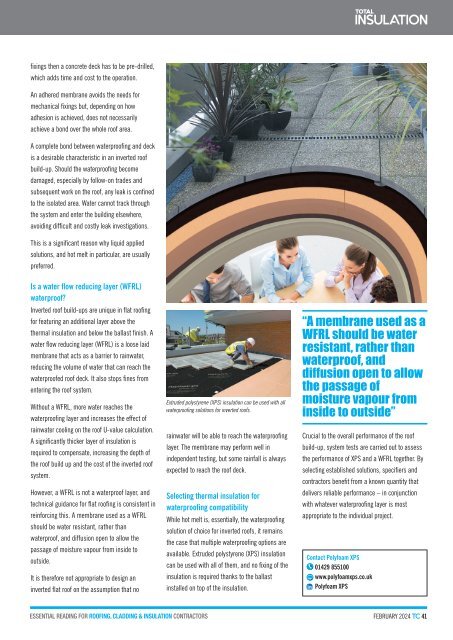February 2024
Create successful ePaper yourself
Turn your PDF publications into a flip-book with our unique Google optimized e-Paper software.
fixings then a concrete deck has to be pre-drilled,<br />
which adds time and cost to the operation.<br />
An adhered membrane avoids the needs for<br />
mechanical fixings but, depending on how<br />
adhesion is achieved, does not necessarily<br />
achieve a bond over the whole roof area.<br />
A complete bond between waterproofing and deck<br />
is a desirable characteristic in an inverted roof<br />
build-up. Should the waterproofing become<br />
damaged, especially by follow-on trades and<br />
subsequent work on the roof, any leak is confined<br />
to the isolated area. Water cannot track through<br />
the system and enter the building elsewhere,<br />
avoiding difficult and costly leak investigations.<br />
This is a significant reason why liquid applied<br />
solutions, and hot melt in particular, are usually<br />
preferred.<br />
Is a water flow reducing layer (WFRL)<br />
waterproof?<br />
Inverted roof build-ups are unique in flat roofing<br />
for featuring an additional layer above the<br />
thermal insulation and below the ballast finish. A<br />
water flow reducing layer (WFRL) is a loose laid<br />
membrane that acts as a barrier to rainwater,<br />
reducing the volume of water that can reach the<br />
waterproofed roof deck. It also stops fines from<br />
entering the roof system.<br />
Without a WFRL, more water reaches the<br />
waterproofing layer and increases the effect of<br />
rainwater cooling on the roof U-value calculation.<br />
A significantly thicker layer of insulation is<br />
required to compensate, increasing the depth of<br />
the roof build up and the cost of the inverted roof<br />
system.<br />
However, a WFRL is not a waterproof layer, and<br />
technical guidance for flat roofing is consistent in<br />
reinforcing this. A membrane used as a WFRL<br />
should be water resistant, rather than<br />
waterproof, and diffusion open to allow the<br />
passage of moisture vapour from inside to<br />
outside.<br />
It is therefore not appropriate to design an<br />
inverted flat roof on the assumption that no<br />
Extruded polystyrene (XPS) insulation can be used with all<br />
waterproofing solutions for inverted roofs.<br />
rainwater will be able to reach the waterproofing<br />
layer. The membrane may perform well in<br />
independent testing, but some rainfall is always<br />
expected to reach the roof deck.<br />
Selecting thermal insulation for<br />
waterproofing compatibility<br />
While hot melt is, essentially, the waterproofing<br />
solution of choice for inverted roofs, it remains<br />
the case that multiple waterproofing options are<br />
available. Extruded polystyrene (XPS) insulation<br />
can be used with all of them, and no fixing of the<br />
insulation is required thanks to the ballast<br />
installed on top of the insulation.<br />
“A membrane used as a<br />
WFRL should be water<br />
resistant, rather than<br />
waterproof, and<br />
diffusion open to allow<br />
the passage of<br />
moisture vapour from<br />
inside to outside”<br />
Crucial to the overall performance of the roof<br />
build-up, system tests are carried out to assess<br />
the performance of XPS and a WFRL together. By<br />
selecting established solutions, specifiers and<br />
contractors benefit from a known quantity that<br />
delivers reliable performance – in conjunction<br />
with whatever waterproofing layer is most<br />
appropriate to the individual project.<br />
Contact Polyfoam XPS<br />
01429 855100<br />
www.polyfoamxps.co.uk<br />
Polyfoam XPS<br />
FEBRUARY <strong>2024</strong> TC 41
















